Thai Ginger and Garlic Noodle Bowls is a flavor-packed vegetarian rice noodle recipe loaded with veggies swimming in a umami filled sauce. Readers share their variations to this maker favorite below! This Asian noodle bowl recipe is easy to make and is also vegan and gluten free.
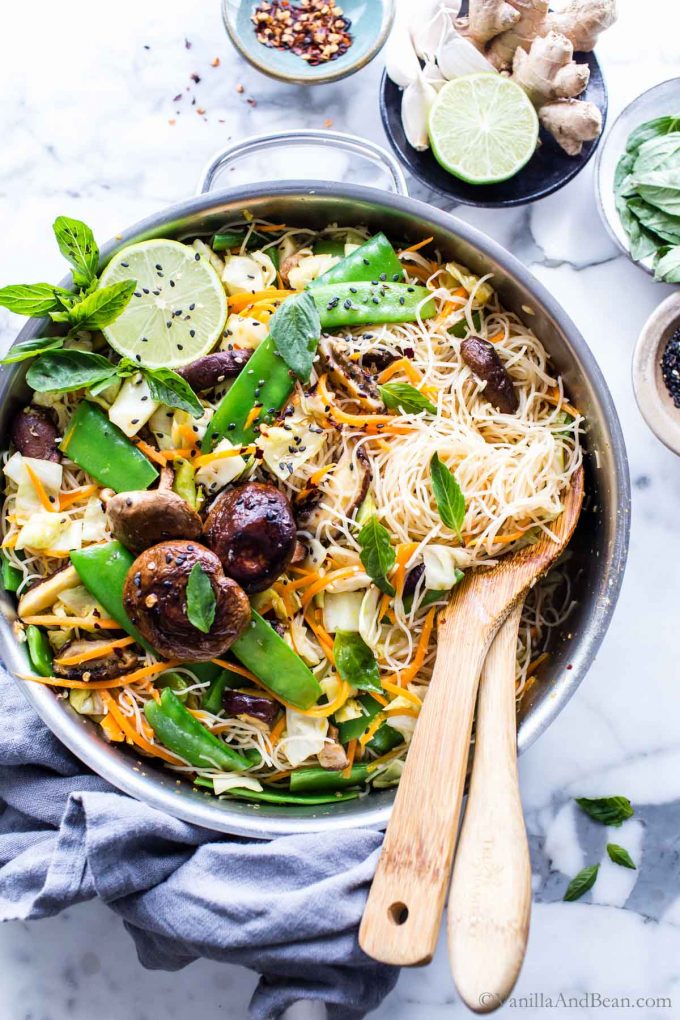
Table of Contents
Thai Inspired Vegetarian Rice Noodle Recipe
Doable for busy weeknights but also for when you just want a fuss free umami filled bit of comfort, stir fry rice noodle bowls to the rescue!
This dish whips up in not time and is packed with oodles of noodles, veggies and a sauce that will knock your socks off! Read on to learn more!
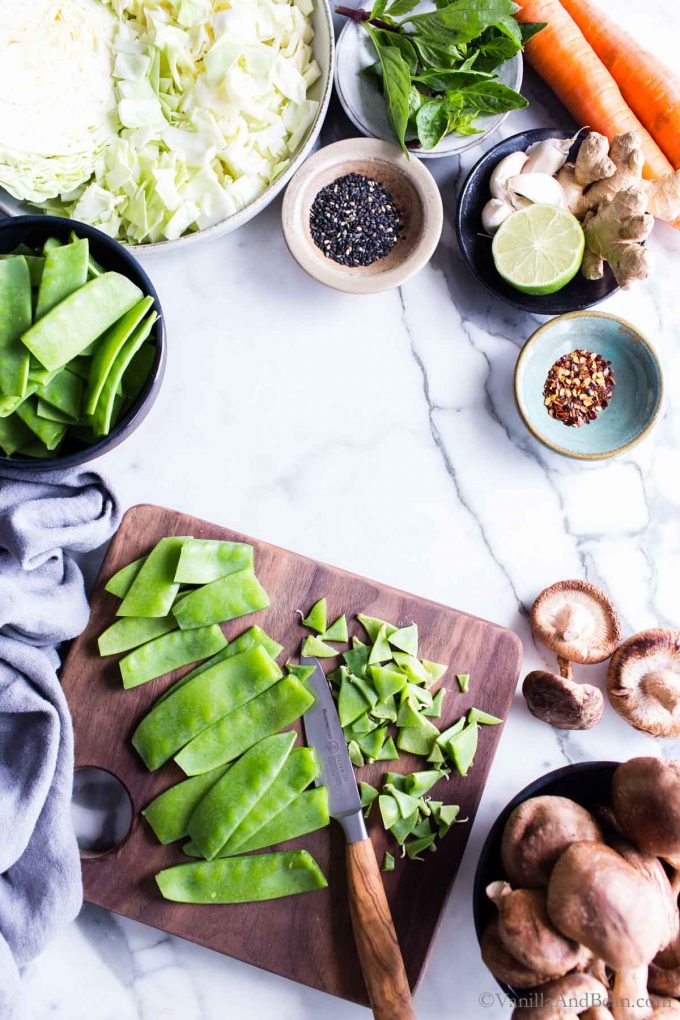
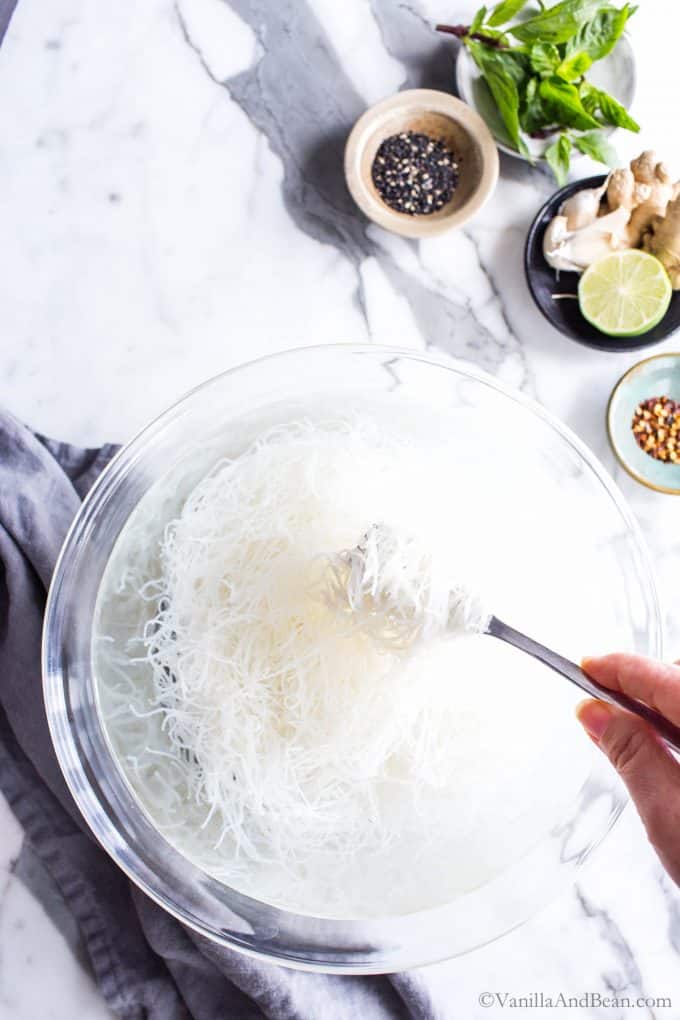
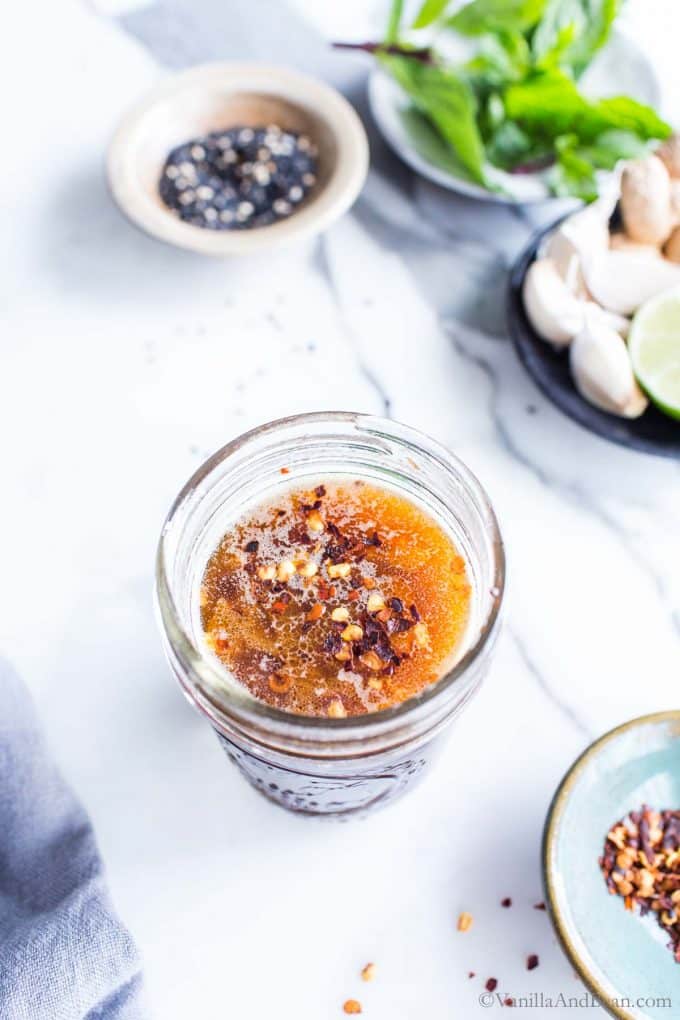
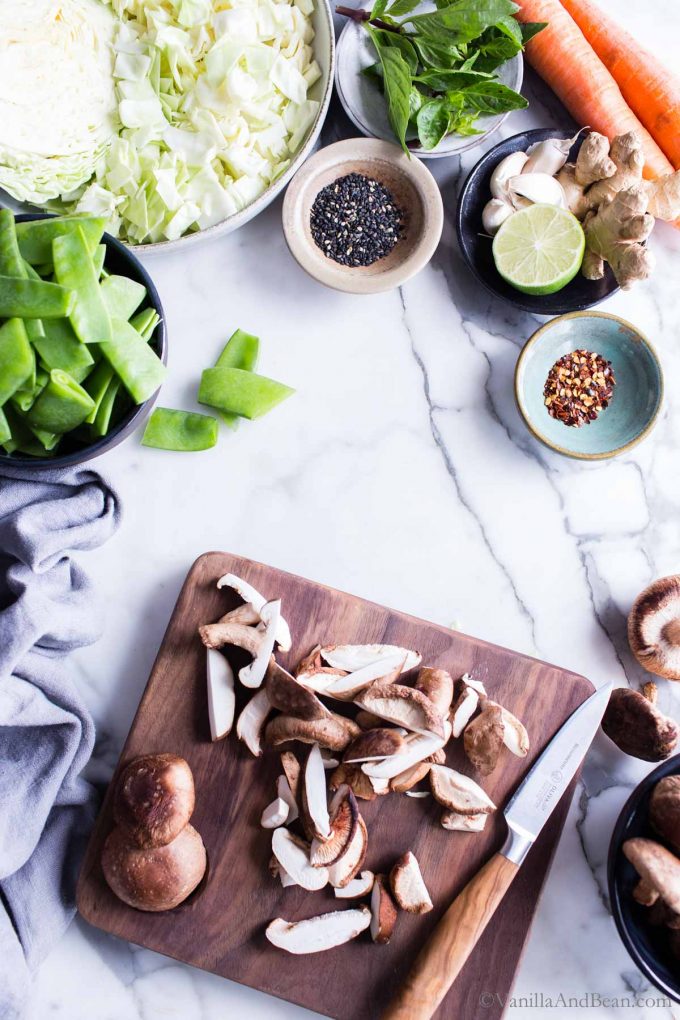
Vegetarian and Vegan Asian Noodle Bowl Ingredients
Pantry staples and fresh veggies come together in this flavorful stir fry recipe. You don’t need a fancy pan or wok to pull this together. Simply use your largest skillet. Here’s what you’ll need to whip it up (see recipe card for details):
For the Sauce:
- Veggie Broth – I use Better Than Boullion.
- Toasted Sesame Oil – offers so much flavor to this recipe.
- Tamari, for a gluten free sauce or use Soy Sauce
- Brown Sugar, Coconut Sugar or Maple Syrup – adds a hint of sweetness to balance the savory.
- Red Pepper Flakes – for a bit of spice. You can take adjust to taste.
For the Noodle Bowls:
- Rice Stick Noodles (aka Vermicelli Rice Noodles) or Bean Thread Noodles
- Snow Peas – for crunch and freshness. If unavailable, use sugar snap peas.
- Sesame Oil – I like toasted, but regular may be used.
- Fresh Ginger and Garlic – adds an authentic Thai flavor to this dish.
- Carrots – for color and freshness.
- Green Cabbage – cooked just until softened, it should still have a little crunch when done cooking.
- Mushrooms – you can use cremini or shiitake in this recipe. I like the texture of shiitake, as they’re a bit meatier, but they can be expensive.
- Fresh Lime Juice – brightens the dish with a hit of acidity.
Is your mouth watering?
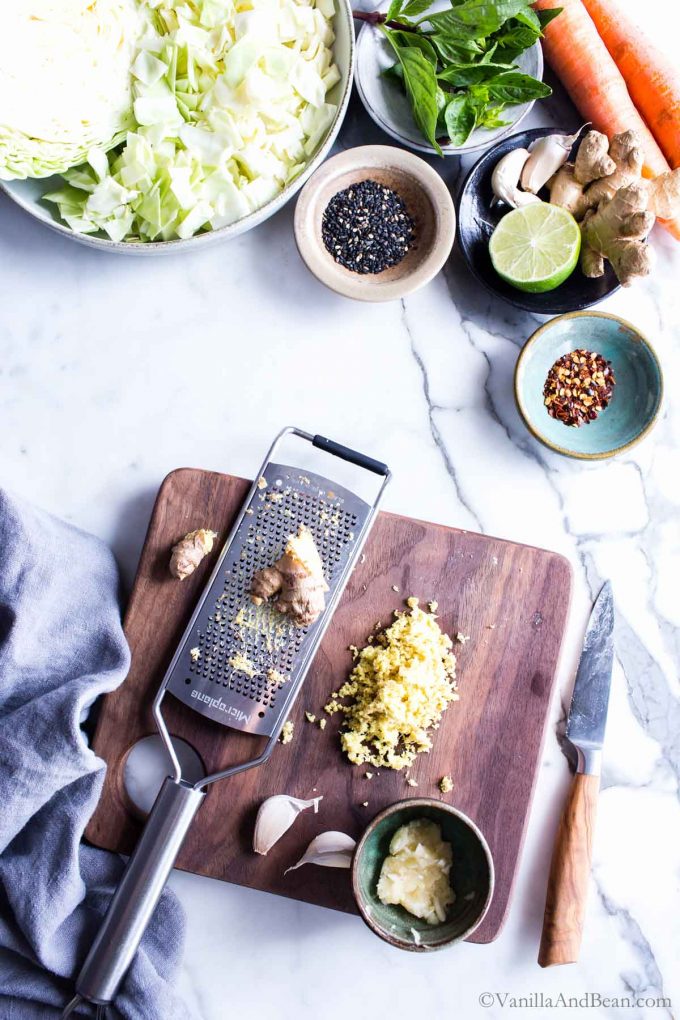
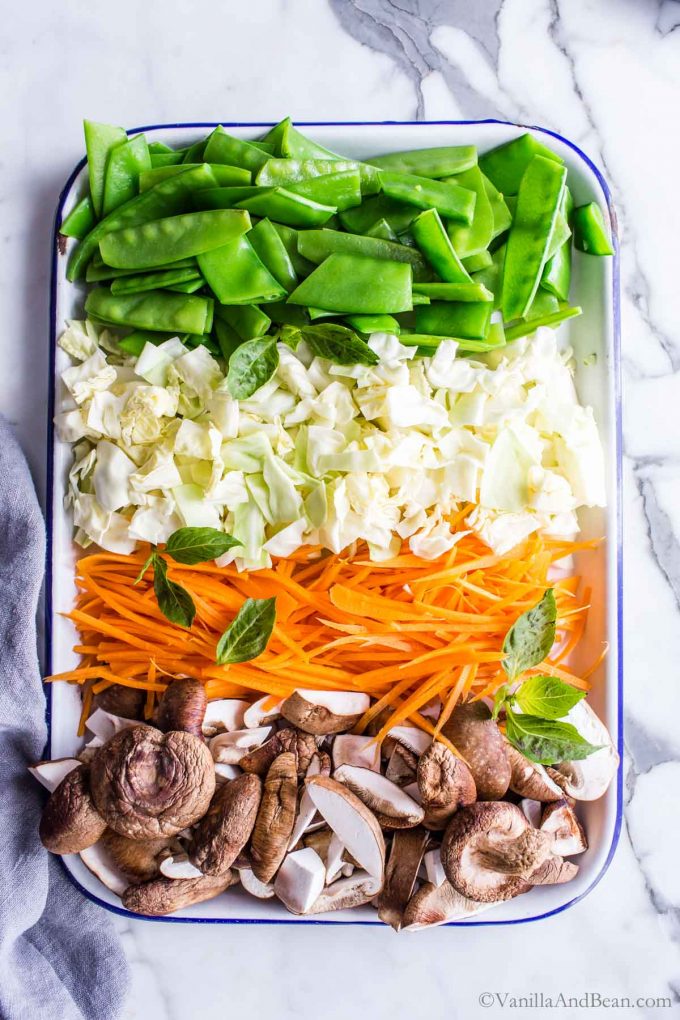
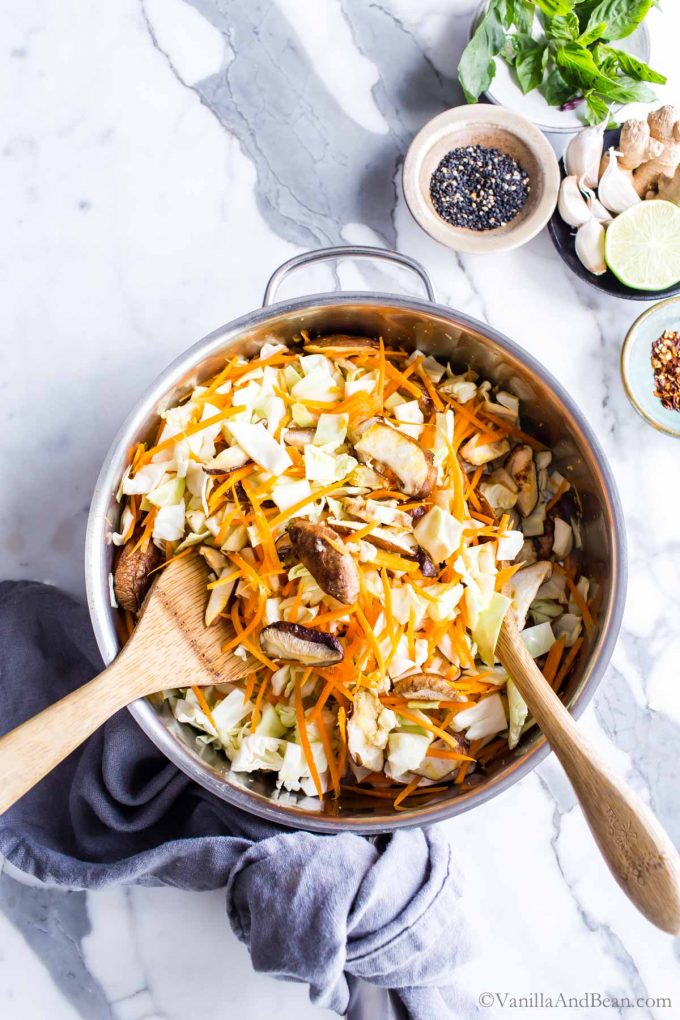
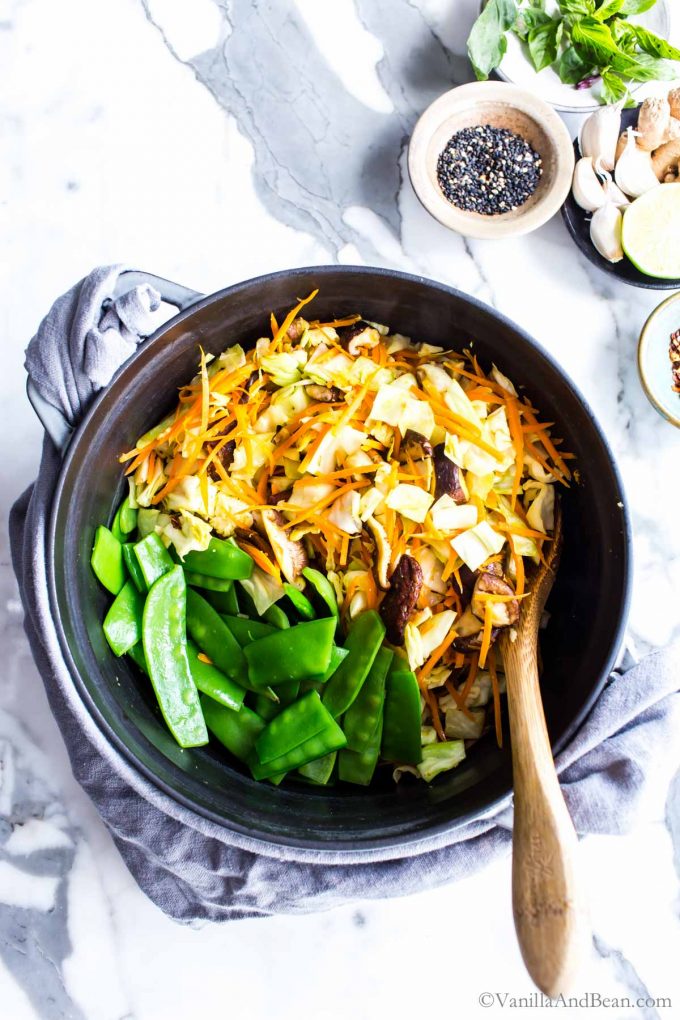
What Type Of Rice Noodles to Use
I tested two types of rice noodles for this recipe, thin (stick) rice noodles and bean thread noodles (rice noodles pictured). Either variety can be used for this scrumptious noodle bowl recipe. I like both but there are differences.
- Bean thread noodles are a bit chewier but seem to pick up the flavors of the sauce more readily than the rice noodles.
- Rice stick noodles (vermicelli rice noodles) have a nice, tender texture and delicious mild flavor, but don’t pick up as much flavor.
While I’ve not tried Asian brown rice noodles in this recipe, one maker did with delicious results. If you give them a try in this noodle bowl recipe, let us know how it goes in the comments!
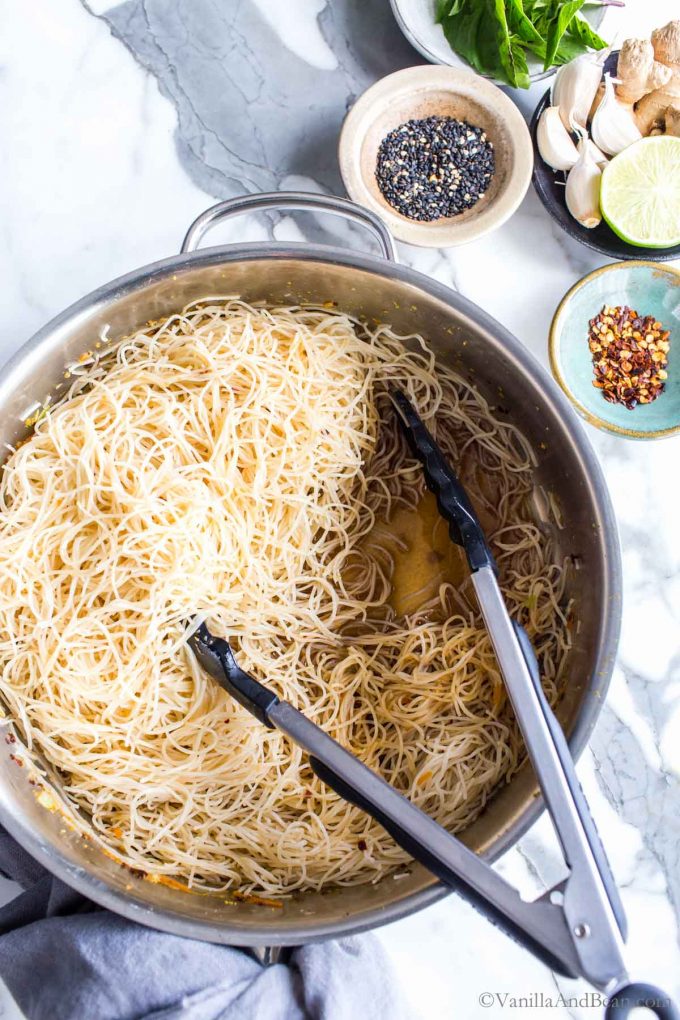
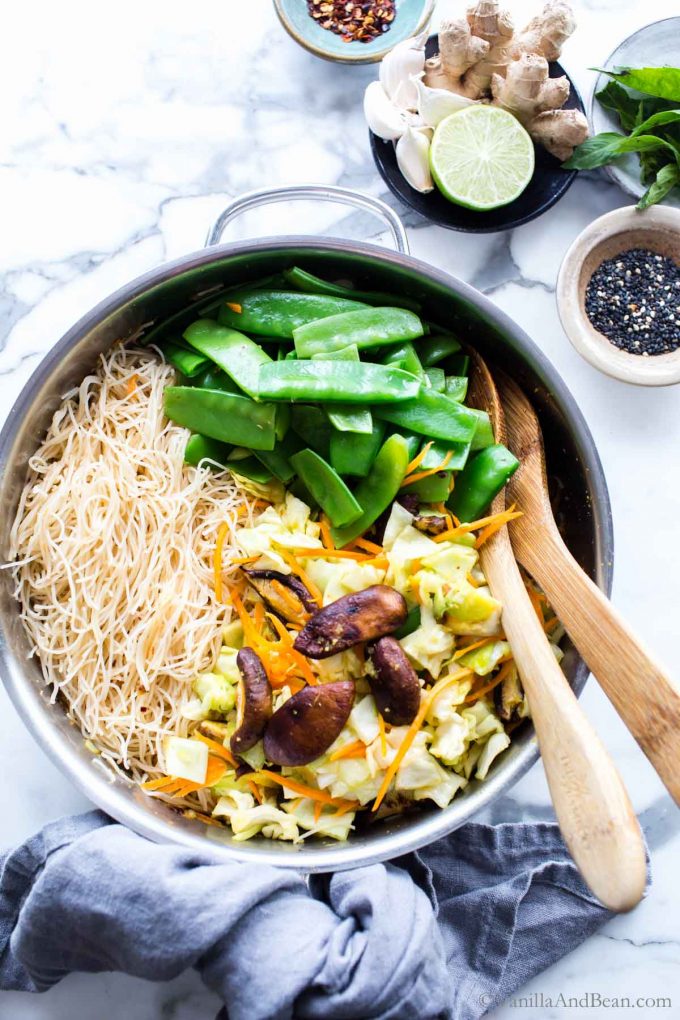
Quick Guide: How to Make an Asian Noodle Bowl
There’s a bit of overlap in prep and cook time, but overall, this recipe comes together in about 45 minutes total time. In summary, here’s how to make this rice noodle stir fry (see recipe card for details):
- First, soak the noodles in cold water.
- Second, while the noodles are soaking, chop the veggies. Blanch the snow peas, drain and put them back in the empty blanching pot.
- Third, make the sauce by shaking the ingredients up in a Mason jar.
- Fourth, stir fry the veggies in a skillet over medium heat and add them to the pot with the blanched snow peas. Set aside.
- Next, gently cook the noodles with the sauce in the same skillet you stir fried the veggies for just a few minutes.
- Last, add the veggies to the noodles and toss together.
Garnish this easy vegan noodle recipe to your hearts delight with lime, sesame seeds, and scallions. Herbs such as mint, cilantro and Thai basil can be used together or alone. They make flavors sing when combined.
Asian Noodle Bowl Variations
This noodle bowl recipe can be paired with your choice of protein, if desired.
- Share With: Your favorite baked, fried, or prepared tofu. If you’re in the mood for a little peanut butter, we love this with my Spicy Peanut Tofu!
- Or: A soft boiled egg is nice too.
- Swaps: The veggies can be swapped with your favorites pretty easily. Sugar snap peas, broccoli or bell pepper are delicious subs.
- See makers notes below to see what the community has shared!
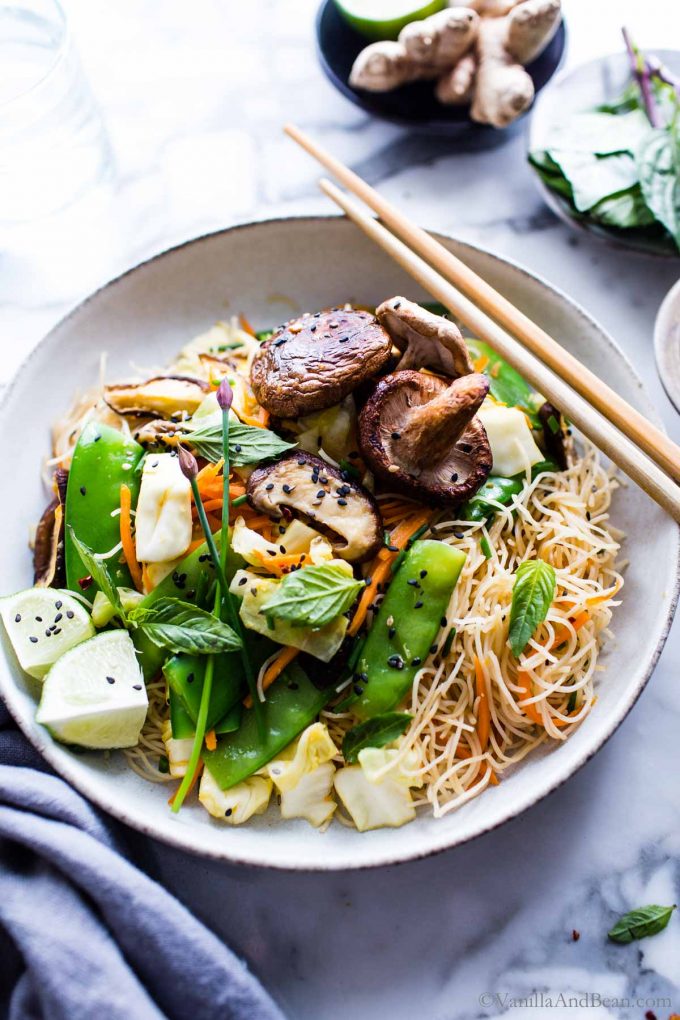
Expert Tips
- Add Protein: This veggie noodle bowl is delicious on its own; however, it can be shared with tofu or egg easily. Prepare your favorite tofu recipe, baked, fried, or prepared or give my spicy peanut tofu a go. A soft boiled egg is nice too.
- Meal Prep: While this recipe comes together in about 45 minutes, you can get a jump on prep by making the sauce, chopping the veggies and blanching the snow peas up to two days in advance.
- Freezer Friendly? I don’t recommend freezing this recipe. The noodles and veggies turn to mush.
Makers Notes
Thank you for sharing your comments and tips below and on social. Here are some highlights!
- Peggy said: “…added some peanuts as people suggested and some sliced
peppers…” - Lisa said: “I left out the mushrooms and added peanuts, lime juice, and cilantro at the end. When I reheated leftovers later in the weekend, I added a little more sesame oil and soy sauce to bring the noodles back to life!”
- Lisa B said: “I added a little tamarind paste to the sauce for sourness and some fried tofu for protein. For the garnish I roasted some white and black sesame, otherwise I stuck closely to the recipe.”
- Suzi said: “I didn’t have mushrooms nor did we have snow peas but instead used broccoli. I blanched that and I used red rice noodles.”
- Darren said: “Made this tonight with spaghetti squash instead of noodles and oh man it was amazing!”
- Margaret said: “I used brown rice noodles and, otherwise, followed the recipe…”
More Noodle Recipes to Love
- Thai Peanut Noodle Salad
- Garlicky Asparagus and Bok Choy Noodle Bowls
- Speedy Miso Mushroom Ramen
- Sesame Ginger Noodle Salad
Thai Ginger and Garlic Noodle Bowl Recipe
Ingredients
- 8 oz (227g) Rice Noodles or Bean Thread Noodles *see note
- 11 oz (310g) Snow peas trimmed
- 1 ½ Tbs Sesame Oil
- 2 tsp fresh Ginger microplaned
- 1 Tbs fresh Garlic microplaned or minced
- 1 1/2 C (150g) Carrots Julianne about two large carrots
- 5 C (400g) Green Cabbage about 1/2 a medium head, cut into bite sized pieces
- 5 oz (142g) Shiitake Mushrooms stemmed and sliced into quarters, cremini work here too.
- 1/2 Lime
For the Sauce
- 1/2 C Vegetable Broth 110g
- 1 Tbs Sesame Oil
- 2 Tbs Tamari
- 1 Tbs Coconut Sugar brown sugar or maple syrup
- ½ tsp Red Pepper Flakes
- ½ tsp Sea Salt
For Garnish
- Scallions slice thin
- Sesame Seeds
- Thai Basil mint and/or cilantro are also nice
- Drizzle of Tamari and/or Sesame Oil
- Lime Wedges
Instructions
For the Noodles
- Place noodles in a large bowl and cover with cold water. These can soak while you prepare the veggies and sauce. (The packages I've seen say to soak in hot water. For me, the noodles turn to mush, so I use a cold soak to soften them, then gently cook them).
For the Veggies
- Fill a stock pot ½ full of water and bring to a boil. While the water is heating, prepare the snow peas by trimming each end. To blanch the snow peas, carefully place them in the boiling water, turn the heat to low and blanch for for exactly two minutes. Drain and rinse with cold water. Place the snow peas back into the empty stock pot they were blanched in (with heat off). Set aside.
For the Sauce
- In a small jar pour in the broth, sesame oil, tamari, sugar, pepper flakes and salt. Lid, shake, then set aside.
To Cook
- In a large skillet or wok, heat the sesame oil on medium high heat. Once shimmering, toss in the grated ginger and garlic. Sizzle for about 30 seconds, then toss in the mushrooms, cabbage and carrots. Using two wooden spoons, stir fry until tender crisp, about 5-6 minutes. When ready, transfer the stir-fried veggies into the pot with the snow peas (heat off). Set aside.
- Check on the rice noodles. They should be tender, but not soft. Drain thoroughly. Set the noodles near the stove. In the same skillet or wok the veggies were stir fried in, pour in the sauce. Bring to a simmer. Once simmering, gently toss in the noodles. Use a pair of tongs to twist and turn the noodles around in the sauce so that each noodle is covered. Turn the heat down continue turning the noodles, cooking for about 2 minutes. Test the noodles for taste and tenderness. If they seem tough, give them another minute to cook while turning the noodles. Remove from heat and stir in the veggies using the residual heat of the noodles to rewarm the veggies.Squeeze in a bit of lime juice, about 1/2 a lime and toss. Taste for seasoning adjustment.
- Garnish with sesame seeds, Thai basil, scallions and a drizzle of sesame oil and/or Tamari. Serve with a wedge of lime and Sriracha on the side.
To Store:
- This recipe is best enjoyed fresh off the stove. The noodles tend to get a bit soggy when reheated. However, it will keep for up to three days in the refrigerator. I do not recommend freezing this recipe.

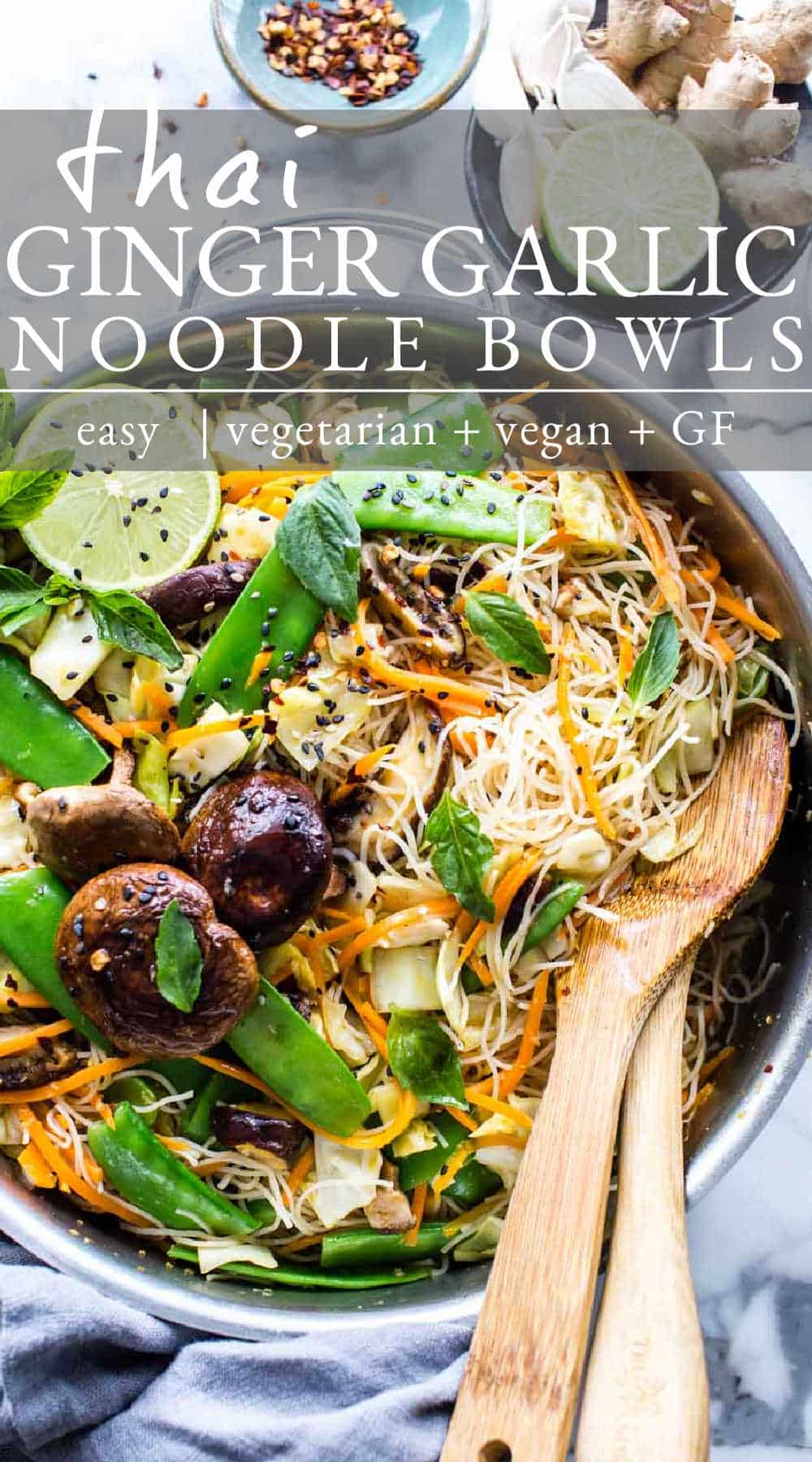
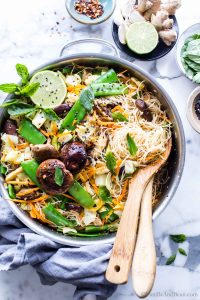

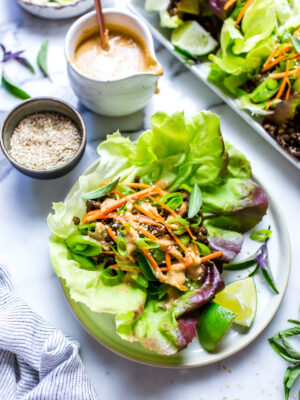
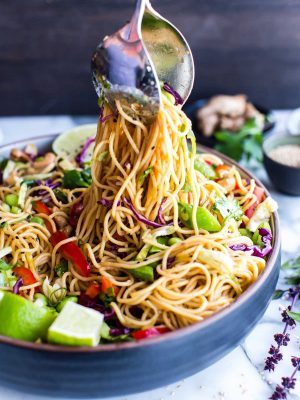
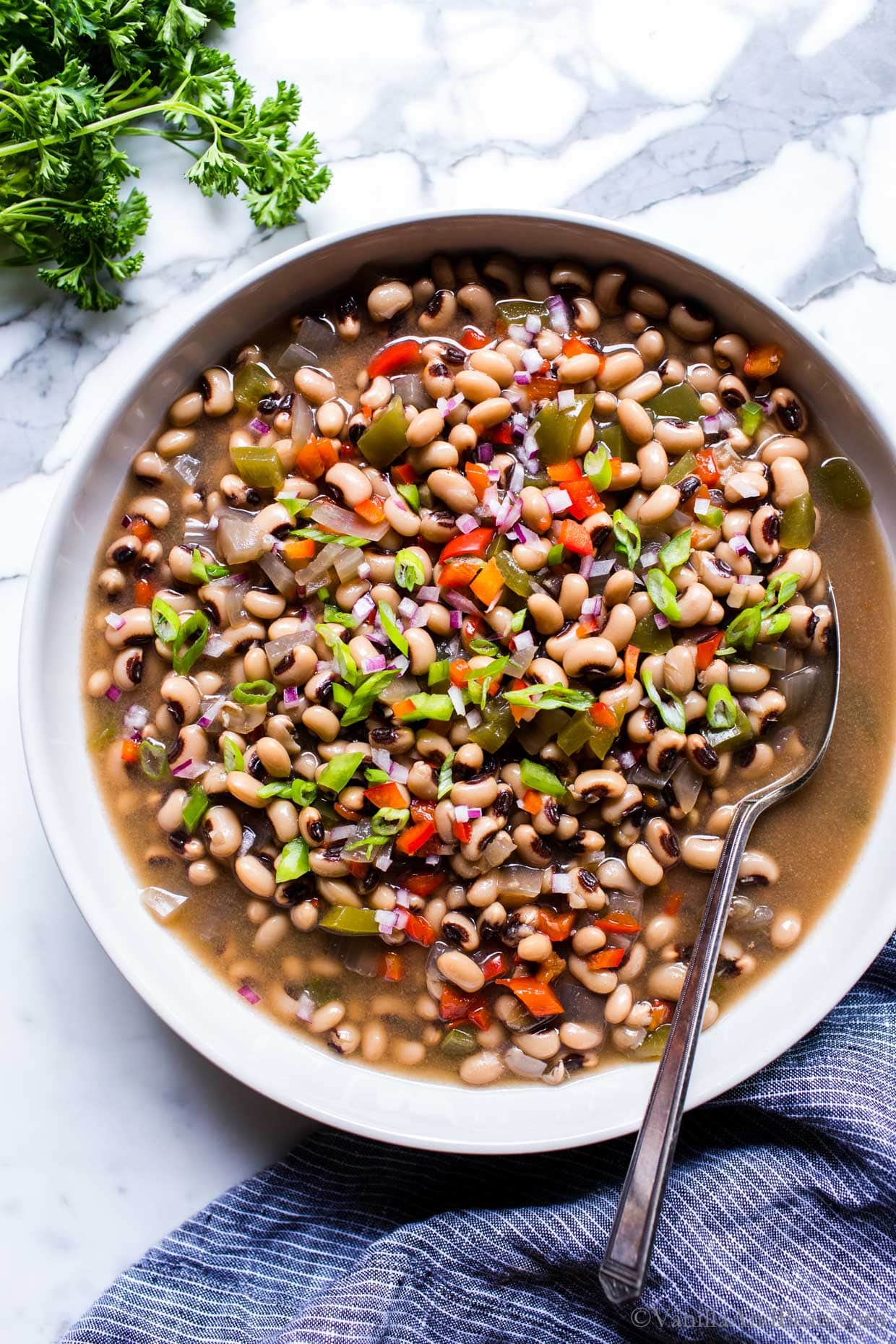
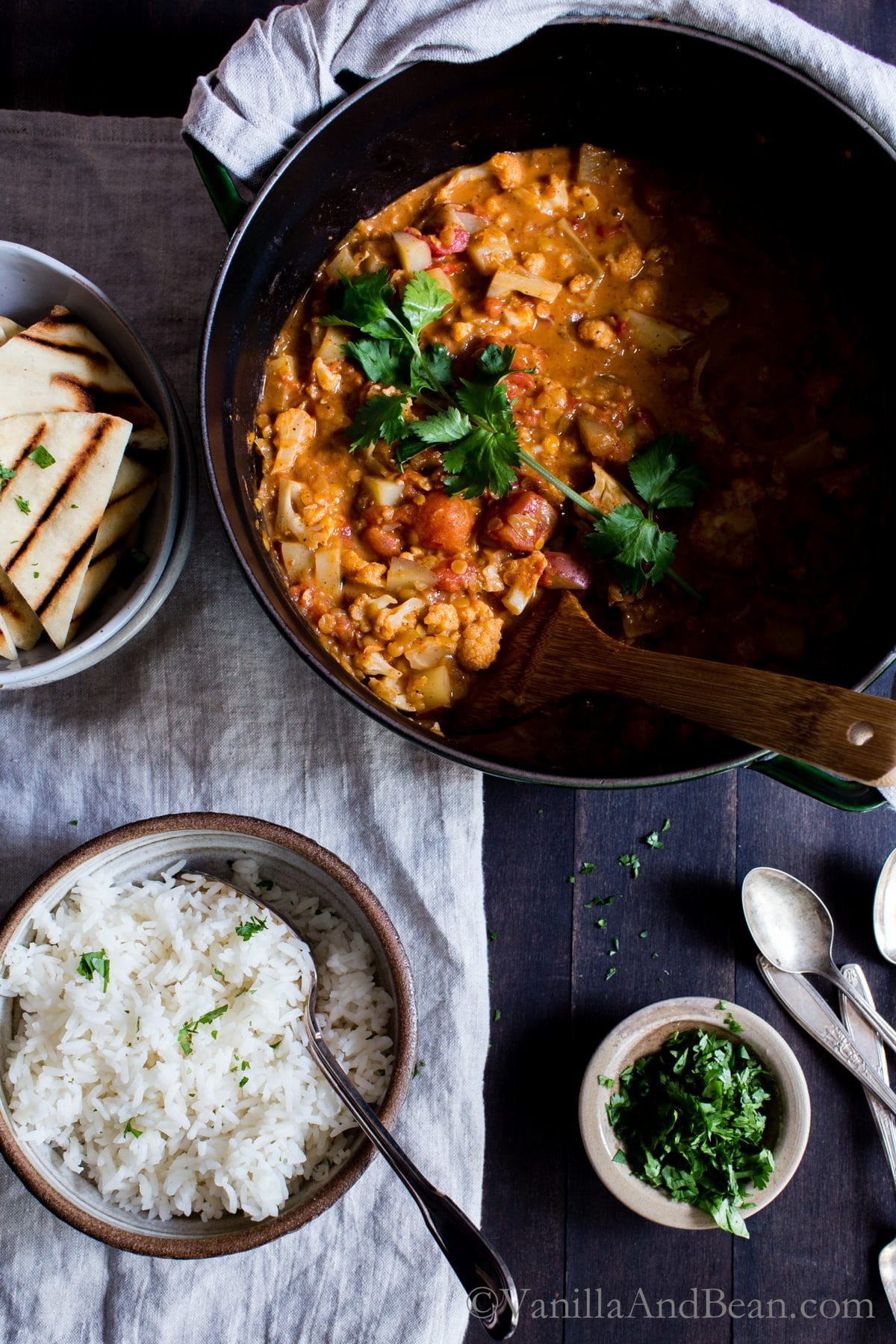
I used coconut aminos Instead of vegetable broth. I used a little bit of Ginger powder, and 2 TBS of toasted sesame oil in the sauce. I cut back on the maple syrup and doubled the red pepper flakes. Great sauce!
Hi Dori! Thank you for your note and sharing your tips! I’m lovin’ that doubled red pepper flakes :D
Could you substitute bok choy for the cabbage in this recipe?
Hi Paula! Yes, that would be delicious! Hold out the tender green tops and add them towards the end of cooking so they just wilt down. Please keep us posted!
This was so delicious! Added some peanuts as people suggested and some sliced
peppers bc I had some to use but other than that made as written and absolutely yummy!
So happy to hear Peggy! Thank you for your note. The peanuts are such a great addition!
Very good. It requires some acid. Perhaps I will try pineapples next time or I see someone added lime in the review section.
Hi Brenda! A squeeze of lime would be fabulous!
Thanks so much for this recipe. I have been craving sesame oil noodle dishes like this lately, so I can’t tell you how much I appreciated being able to make a big batch of noodles and enjoy them this weekend. I followed the recipe except for a few changes: I left out the mushrooms and added peanuts, lime juice, and cilantro at the end. When I reheated leftovers later in the weekend, I added a little more sesame oil and soy sauce to bring the noodles back to life!
Thanks so much for explaining how to cook rice noodles as well! The package I bought had no instructions and the cold water soak worked perfectly. Thanks again!
Hi Lisa! Thank you so much for coming back and leaving a note! Aren’t noodle bowls SO good? I need to share more noodle recipes! OMGeee… and yes, about cooking those noodles. I always cold soak. Cooking just a little too long turns them to mush!
This recipe is amazing. Thank you so much for sharing!!! I loved reading the detailed information you shared about organic and non-GMO food products as well. I would love to ask you (as I am always on the hunt for truly Whole Foods), what Organic and non-GMO products have you found hat you buy in bulk for your family? Very eager to hear any good food items I may not have known about.
Hi Sarah! Thank you so much for your note. I’m so happy to hear the post resonated with you. Organic AND non-GMO can be hard to find, currently, so I prioritize organic, while keeping an eye out for organic and non-GMO. At our food Co-Op, I buy quite a bit of food in bulk, mostly beans, lentils, dried peas, sugar, salt, spices, dry herbs, kasha, and grains like quinoa, oats, millet, rice etc. Not all are both Organic and non-GMO, so again, I prioritize organic. There are a few brands that do offer both organic and non-GMO like Nutiva, Bob’s Red Mill, Frontier Co-op, Theo Chocolate for example (in full disclosure – these are sponsors of V&B, but they are also brands I’ve been using since before I started blogging). Our Co-Op also carries locally milled grains and several of those are organic and non-GMO. The bulk bins should be labeled accordingly. If unsure, check with the bulk department manager and ask them questions. I find stores are eager to learn what their customers want. This feedback is invaluable and I find it works! Next on my list is fair trade and organic bananas (do a quick google search why bananas are so darn cheep – and pineapples too!). There’s so much to consider when purchasing food. But our purchases DO matter. I hope this helps, Sarah!
This was a fantastic dish and really easy to make. I added a little tamarind paste to the sauce for sourness and some fried tofu for protein. For the garnish I roasted some white and blck sesame, otherwise I stuck closely to the recipe. Thank you for thinking of the Europeans and adding the metric measurements! :)
Luckily I have some experience and knew that my boyfriend and me would eat the whole 4-portion amount.
Thanks so much for giving me a great introduction to bowls, already excited for trying more!
Hi Lisa! Thank you so much for your note and kind words. So happy to hear the metric measurements are helpful. :D Love that fried tofu addition and tamarind paste (I just added that to my refrigerator staple collection and am excited to give it a go in more recipes)! I’ll be adding that next time I whip this up – delicious! I hope you enjoy all the bowls, Lisa! They really are so satisfying!
This was fantastic!!! I used brown rice noodles and, otherwise, followed the recipe….Hubby loved it, too! Recently found your site and am a new vegan and look forward to trying many more of your recipes that look yummy. On a side note, we just returned this fall from a visit to Whidbey Island (my first ever) for the 75th anniversary of the naming of Ault Field! Was really a meaningful trip and WA state is so beautiful!!!
Definitely amazing! We followed your noodle preparation but added shrimp and chopped peanuts and lime for garnish!!! Definite recommend!!!!
You already have the raves but here’s one more!! I just made this and it came together so beautifully and in no time!! I didnt have mushrooms nor did we have snow peas but instead used broccoli. I blanched that and I used red rice noodles. YUMMO!!! Even heard moans at the table from the others!! That’s always a good sign, right?
Hi Suzi! Thank you so much for coming back and leaving a note! Hooray! I love that you enjoyed this recipe and made the broccoli adjustment! Perfection and SOOOO good! Moans at the table = good sign! Yeah!
Made this tonight and the flavor is perfect but the noodles turned out totally mushy. We followed the recipe exactly, so I’m not sure what I did wrong. Any tips?
Oh no, Jesse. I’m sorry to hear this. Because I wasn’t there with you, I’m not sure what went wrong. I wonder how long the noodles were soaked and in hot or cold water. How long were they cooked. Did you use rice noodles?
Made this tonight with spaghetti squash instead of noodles and oh man it was amazing! Great simple fresh and delicious recipe! thanks!
Oh my, spaghetti squash!? What a great idea! So happy to hear ya’ll enjoyed it Darren – thank you so much for coming back and leaving your tip and note!
Made this tonight with rice noodles and added prawns that I sauteed in sesame oil and garlic and ginger. Omg so Good!! Son doesn’t like the texture of the rice noodles so will try the bean noodles next time. There will definitely be a next time… Thank you for the recipe!
Hooray, hooray! Thank you for coming back and leaving a note, Shannon!
This might be a little dramatic but I think this was the best dish I’ve ever eaten. It’s so easy to make and the flavours are so amazing. I made mine with purple cabbage because that’s what I had and it added a beautiful colour and tasted great.
Thank you so so much for this amazing recipe! Will share with all my friends.
Thank you for sharing your drama, Katie! I love reading this! Easy, yes, and I love the flavors too. Thank you so much for your note and sharing with friends!
I have been experimenting cooking Aisan food. This is by far the best dish I have cooked. I saved some prep time by using matchstick carrots. I also purchased pre cooked noodles in the produce department of my local Aisan market. Only took 10 seconds in boiling water and they were perfect.
Thank you so much for your note, Carole! Hooray for a tasty Asian recipe – so happy to hear! Thank you for sharing your notes too!
Hiii Kate!! Yum, yum yummmm! Thank you for sharing… I’m so happy you enjoyed the recipe! xo
Tried this last week and about to make it a second time. Loved it! Btw, in the list of ingredients you have vegetable broth but then nowhere in the recipe does it say where to use it. I added it to the sauce… is that what you do?
Thank you again for the inspired recipes.
Hooray! So happy you love the recipe, Alexandra! You’re right on about the broth. Thank you for your note! :D
Yup.. agreed, Kathleen. Thank you for your pin! xo
I just found this on Pinterest and had to come over. What a great recipe, love the ginger and garlic. I’ll be making this soon, thanks!
This is a very pretty dish and I love ginger and garlic with noodles. Comfort food without being too heavy.
Hi Virginia! Thank you! Blanching the snow peas and the contrasting carrots really make the colors pop. I hope you enjoy the recipe!